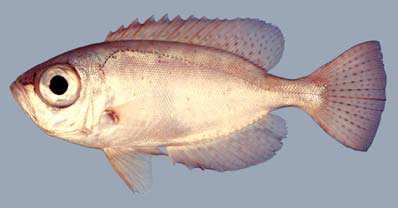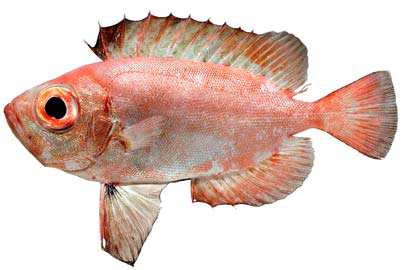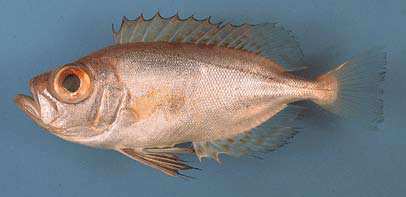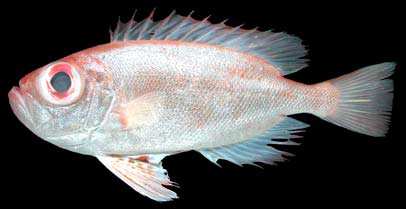PRIACANTHIDAE
Bigeyes
By Yukio Iwatsuki
 Heteropriacanthus cruentatus |
 Priacanthus blochii |
 Priacanthus hamrur |
 Priacanthus macracanthus |
 Priacanthus tayenus |
 Pristigenys niphonia |
|
Medium sized marine fishes; maximum length about 35 cm. Body deep, compressed, and covered with extremely adherent, rough, spiny scales; eyes very large; mouth large, oblique; branchiostegal membrane scaled. Dorsal fin single with X spines and 11-15 soft rays; anal fin with III spines and 10 to 16 soft rays; prominent to remnant spine at angle of preopercle; scales much modified, varying among genera and species; pelvic-fin insertion located anterior to pectoral-fin base; innermost ray of pelvic fin broadly connected to belly by membrane; caudal fin not forked. Color: head and body bright silvery white on side and below; tip of snout and nostrils black; posterior margin of caudal fin black; ventral margin of lower caudal lobe white; 1st pelvic-fin ray white; anal fin white. Similar families occurring in the area. Holocentridae: readily discernible from bigeyes by spines on opercular margin, spinous and soft-rayed portions of dorsal fin nerarly separate, deeply forked caudal fin with 18-19 rays; pelvic fins having I spine and usually 7 soft rays and not attached to belly by membrane, and IV anal-fin spines. Berycidae: readily distinguishable from bigeyes by a short-based dorsal fin with only IV-VII spines, anal fin with IV spines, caudal fin deeply forked, and pelvic fins with 7-13 soft rays. Remarks. Occurring in shallow coral reef or rocky shore or similar environmental condition at depths of deeper waters (1-400 m); widespread in the Indo-Pacific, eastern Pacific and Atlantic. |

|
|